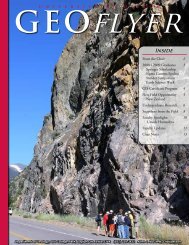Stander Symposium abstract book - University of Dayton
Stander Symposium abstract book - University of Dayton
Stander Symposium abstract book - University of Dayton
Create successful ePaper yourself
Turn your PDF publications into a flip-book with our unique Google optimized e-Paper software.
POSTER SESSION 1<br />
The filter is a grounded coplanarwaveguide structure which has 2.4mm by 2.4mm dimension with center frequency at 10GHz, thebandwidth is<br />
0.4GHz, the insertion loss is 1.7dB and the quality factor is 25.<br />
Building and Testing <strong>of</strong> an Adaptive Optics System for Optical Microscopy<br />
Presenter(s): Zhenyu Yang<br />
Advisor(s): Qiwen Zhan<br />
Electro-Optics Graduate Program - Graduate Research<br />
Adaptive optics (AO), as the technology <strong>of</strong> compensating the wavefront distortion can significantly improve the performance <strong>of</strong> existing optical<br />
systems. An adaptive optics system is used to correct the wavefront distortion caused by the imperfection <strong>of</strong> optical elements and environment.<br />
It was originally developed for military and astronomy applications to mitigate the adverse effect <strong>of</strong> wavefront distortions caused by Earthâs<br />
atmosphere turbulence. With a closed-loop AO system, distortions caused by the environment can be reduced dramatically. As the technology<br />
matures, AO systems can be integrated into a wide variety <strong>of</strong> optical systems to improve their performance. The goal <strong>of</strong> this project is to build<br />
such an AO system which can be integrated into high-resolution optical microscopy. A Thorlabs Adaptive Optics Kit was set up. A Shack-Hartmann<br />
Wavefront sensor, a Deformable Mirror and other necessary optics hardware was combined together on a breadboard, and the control s<strong>of</strong>tware<br />
was also implemented to form the feedback loop.<br />
Experimental Confirmation <strong>of</strong> Strong Fluorescence Enhancement Using One-dimensional<br />
GaP/SiO2 Photonic Band Gap Structure<br />
Presenter(s): Jian Gao<br />
Advisor(s): Andrew M Sarangan, Qiwen Zhan<br />
Electro-Optics Graduate Program - Graduate Research<br />
We report the experimental confirmation <strong>of</strong> the fluorescence enhancement effect using a one-dimensional photonic band gap (1D PBG) structure.<br />
This 1D PBG structure consists <strong>of</strong> periodic multilayer thin films with gallium phosphide (GaP) and silicon dioxide (SiO2) as the alternating high<br />
and low index materials. Strong evanescent field enhancement can be generated at the last interface due to the combination <strong>of</strong> total internal<br />
reflection and photonic crystal resonance for the excitation wavelength. In addition, the 1D PBG structure is designed as an omnidirectional<br />
reflector for the red-shifted fluorescent signal emitted from the surface bounded molecules. This omnidirectional reflection function helps to<br />
improve the collection efficiency <strong>of</strong> the objective lens and further increase the detected fluorescent signal. Compared with the commonly used<br />
bare glass substrate, an average enhancement factor <strong>of</strong> 69 times has been experimentally verified with quantum dots as the fluorescent markers.<br />
This fluorescence enhancer may find broad applications in single molecular optical sensing and imaging.<br />
Metal Nanorod Structures: Electromagnetic and quantum confinement properties<br />
Presenter(s): Li Li<br />
Advisor(s): Joseph W Haus<br />
Electro-Optics Graduate Program - Graduate Research<br />
The purpose <strong>of</strong> this work is to understand electromagnetic plasmonic response and electron quantum confinement in an ellipsoidal metallic<br />
nanorod. The plasmon resonance <strong>of</strong> metallic nanorods displays geometric tunability controlled by the ratio <strong>of</strong> its minor to major axes. The surface<br />
plasmon resonance (SPR) <strong>of</strong> metallic nanorods (Ag, Au, Cu) based on Mie theory is studied for different geometries and physical environments.<br />
Moreover, we calculate the electron density <strong>of</strong> states for the nanowire geometry. Combining the density <strong>of</strong> state with the Fermi-Dirac distribution<br />
produces very sharp electron energy distribution. We present theoretical results based on SPR theory and the electron density <strong>of</strong> states. Our results<br />
are a first step in understanding more complex metal-insulator-metal structures for energy harvesting applications.<br />
69

















